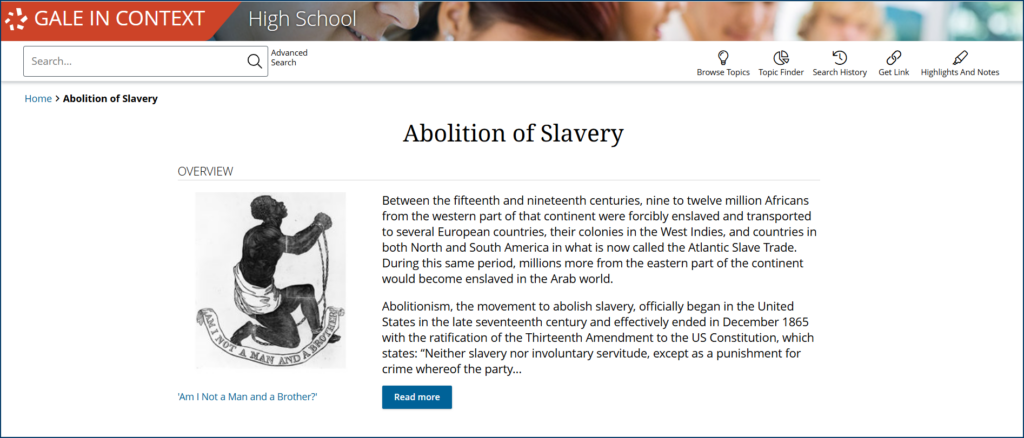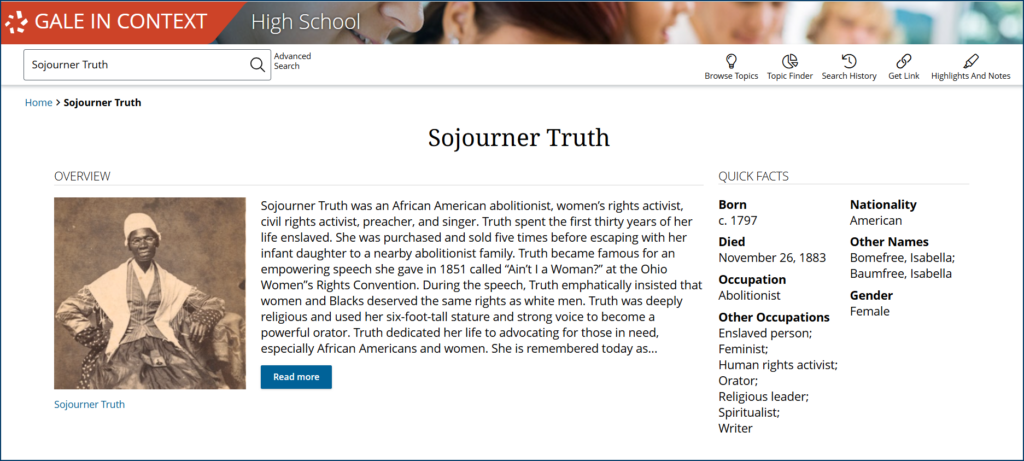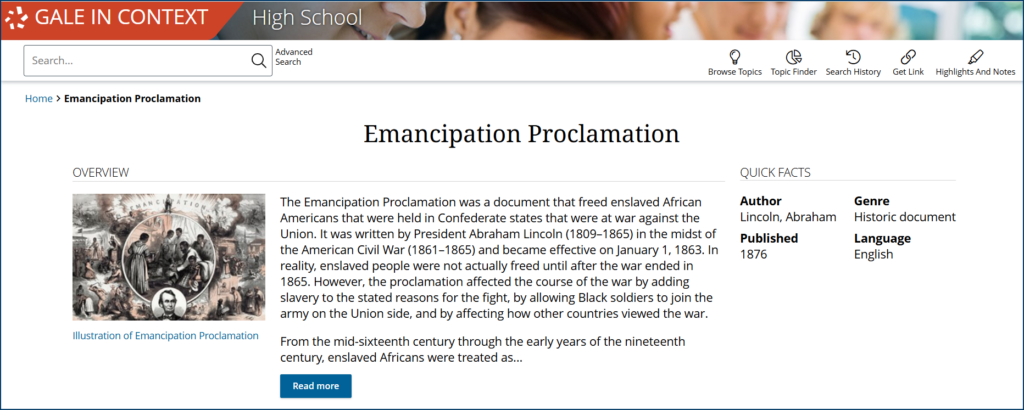| By Gale Staff |
Slavery is a dark chapter in American history. The Atlantic slave trade forced an estimated 12.5 million West Africans into enslavement—and from that number, an estimated 2 million died during the Atlantic crossing. The U.S. government considered these men and women to be the personal property of their owners. In addition to being forced into grueling manual labor and experiencing physical abuse, they were stripped of their culture and often separated from their families.
Although the Atlantic slave trade persisted for centuries, many disagreed with and actively resisted the practice. Groups of enslaved people rose against their captors, and many white people, including some religious denominations (notably the Quakers), spoke out against slavery, recognizing that all people were entitled to basic human rights.
Slavery created a significant rift within the fabric of the still-young United States, one which would have considerable social and political consequences. This tension triggered the nation’s bloody Civil War, which claimed the lives of more than 600,000 Americans (2% of the country’s entire population at the time). However, the war’s resolution ultimately led to the creation of the Thirteenth Amendment to the United States Constitution, formally abolishing the practice of slavery.
The abolition movement is a story of ordinary citizens acting together to radically change society for the better. Explore the path to abolition with Gale In Context: High School, which provides helpful resources that are both curriculum-aligned and vetted by experts.
Our extensive Abolition of Slavery topic page includes detailed summaries, academic journal articles, audio files, and other valuable tools to supplement your lesson plan. With Gale In Context: High School, your students can independently pursue their own research on historical topics like slavery, the Civil War, and abolition that have far-reaching implications, even today.
Meet the Cast of Abolitionist Leaders
Your students are likely familiar with the major figures in the abolition movement. Names like Frederick Douglass and Harriet Tubman immediately come to mind—and Gale In Context: High School has committed portals for both. Still, there were many other inspiring individuals whose commitment helped spur the movement forward.
Let’s take a look at just a few of them.
Sojourner Truth
Sojourner Truth, born Isabella Baumfree in New York, spent the first 30 years of her life in slavery. In 1826, an abolitionist Quaker family bought her freedom, and just one year later, New York abolished slavery. As a legally free woman, she became a traveling preacher and quickly gained influence and renown with her powerful oratory skills and singing voice.
In 1844, Truth joined the Northampton Association of Education and Industry and found herself amidst a network of notable leaders in the abolition movement. She attended speeches by Frederick Douglass, met William Lloyd Garrison, and even collaborated with Harriet Beecher Stowe on an article in The Atlantic titled “Sojourner Truth, the Libyan Sibyl.” The article subsequently provided Truth with a national audience.
In 1851, Truth delivered her “Ain’t I a Woman?” speech, advocating for voting rights regardless of sex or race, at the Women’s Rights Convention in Akron, Ohio. The oration, spoken to a predominantly white audience, is considered one of the most important speeches in U.S. history. Once the Civil War started, Truth was a vital member of the Union’s war efforts, and she even spoke to then-president Abraham Lincoln on the topic of segregation.
Throughout her life, Truth never learned to read or write, nor was she ever fully reunited with her family. Despite these hardships, she was an instrumental member of the abolition movement.
William Still
Born in 1821, William Still was a key strategist for the Underground Railroad, the secret network of anti-slavery safehouses that guided an estimated 100,000 enslaved people to freedom. Still’s parents were both formerly enslaved—but his father was able to purchase his freedom, and his mother escaped slavery. Thanks to their perseverance and courage, Still was born free.
As a young adult, Still moved to Philadelphia to work as a janitor for the Pennsylvania Society for Promoting the Abolition of Slavery. He quickly rose in the group and would actively operate a stop on the Underground Railroad in his home. In this role as a conductor on the Philadelphia escape route, Still became incredibly effective in securing safe lodging for enslaved people on the run. He even visited Canada after the fact to ensure the people he assisted safely settled into their new lives.
Still’s contributions put him at constant risk of legal prosecution. Despite that threat, he collected his interviews and personal accounts in a book, giving historians unique insight into the courage of these refugees. His meticulous documentation was also valuable in reconnecting missing family members.
Review Major Events
In addition to the Civil War, several significant events led to the abolition of slavery in the United States. Gale in Context: High School can help you break down a century’s worth of history to provide valuable context to this pivotal period.
The practice of slavery in the United States existed well before the Revolutionary War and was a topic of debate for our Founding Fathers—many of whom were slave owners themselves. By the late 1700s, as the American Revolution unfolded, some colonies began developing a more enlightened perspective around liberty and freedom, a view that questioned the morality of slavery and created an early fault line in the newly established United States.
In 1787, Congress passed the Northwest Ordinance, establishing protocols for the country’s westward expansion and admission into the Union. Notably, slavery was banned within this new territory, setting the tone for the future growth of the United States. Then, in 1808, Congress outlawed the importation of enslaved people. Several predominantly northern states soon banned the practice entirely; Vermont led the way, abolishing slavery in its state constitution in 1777.
Meanwhile, the abolitionist movement was growing, and thousands of enslaved people escaped from the South to the North—some even crossed the border into Canada. In 1859, abolitionist John Brown led an unsuccessful raid on the federal arsenal at Harpers Ferry in what was then Virginia. He had hoped to steal weapons and distribute them to enslaved people, igniting a revolt. Southern leaders viewed the attack as proof that abolitionists in the North were willing to use violence for their cause. Brown was hanged, but he became a martyr for the antislavery cause.
By 1861, seven southern states pushed to secede from the United States, launching the country into a bloody war against itself. In 1862, President Lincoln issued the Emancipation Proclamation, declaring all enslaved people in the Confederate States to be free. In 1863, Lincoln delivered the Gettysburg Address, which, while not directly addressing slavery, harkens to “a new birth of freedom” for the country. Finally, in 1865, Congress ratified the Thirteenth Amendment, federally prohibiting slavery.
The history of slavery and its eventual abolition has significant implications for contemporary issues around civil rights. Regardless of what the federal laws dictate, the country still struggles to create equitable opportunities for black Americans. In fact, some scholars point out that the Thirteenth Amendment did not comprehensively abolish slavery, as it permits an exception in the form of criminal punishment.
As illustrated by the Black Lives Matter movement, minorities face ongoing and systemic barriers to success, notably in areas such as living conditions, employment opportunities, and wealth accumulation. According to the nonprofit Economic Policy Institute, in 2019, a black person in the U.S. labor market earned 24.4% less than a typical white person—a wealth gap that has increased in recent decades.
Gale In Context’s user-friendly collections are an essential companion to understand the past, and how it led us to where we are today. If your institution is not a subscriber, contact your local sales representative to learn more and access a trial.




